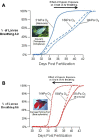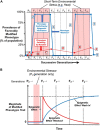"Bet hedging" against climate change in developing and adult animals: roles for stochastic gene expression, phenotypic plasticity, epigenetic inheritance and adaptation
- PMID: 37869716
- PMCID: PMC10588650
- DOI: 10.3389/fphys.2023.1245875
"Bet hedging" against climate change in developing and adult animals: roles for stochastic gene expression, phenotypic plasticity, epigenetic inheritance and adaptation
Abstract
Animals from embryos to adults experiencing stress from climate change have numerous mechanisms available for enhancing their long-term survival. In this review we consider these options, and how viable they are in a world increasingly experiencing extreme weather associated with climate change. A deeply understood mechanism involves natural selection, leading to evolution of new adaptations that help cope with extreme and stochastic weather events associated with climate change. While potentially effective at staving off environmental challenges, such adaptations typically occur very slowly and incrementally over evolutionary time. Consequently, adaptation through natural selection is in most instances regarded as too slow to aid survival in rapidly changing environments, especially when considering the stochastic nature of extreme weather events associated with climate change. Alternative mechanisms operating in a much shorter time frame than adaptation involve the rapid creation of alternate phenotypes within a life cycle or a few generations. Stochastic gene expression creates multiple phenotypes from the same genotype even in the absence of environmental cues. In contrast, other mechanisms for phenotype change that are externally driven by environmental clues include well-understood developmental phenotypic plasticity (variation, flexibility), which can enable rapid, within-generation changes. Increasingly appreciated are epigenetic influences during development leading to rapid phenotypic changes that can also immediately be very widespread throughout a population, rather than confined to a few individuals as in the case of favorable gene mutations. Such epigenetically-induced phenotypic plasticity can arise rapidly in response to stressors within a generation or across a few generations and just as rapidly be "sunsetted" when the stressor dissipates, providing some capability to withstand environmental stressors emerging from climate change. Importantly, survival mechanisms resulting from adaptations and developmental phenotypic plasticity are not necessarily mutually exclusive, allowing for classic "bet hedging". Thus, the appearance of multiple phenotypes within a single population provides for a phenotype potentially optimal for some future environment. This enhances survival during stochastic extreme weather events associated with climate change. Finally, we end with recommendations for future physiological experiments, recommending in particular that experiments investigating phenotypic flexibility adopt more realistic protocols that reflect the stochastic nature of weather.
Keywords: climate change; development; phenotypic plasticity; stochasticity; weather.
Copyright © 2023 Burggren and Mendez-Sanchez.
Conflict of interest statement
The authors declare that the research was conducted in the absence of any commercial or financial relationships that could be construed as a potential conflict of interest.
Figures








Similar articles
-
Developmental phenotypic plasticity helps bridge stochastic weather events associated with climate change.J Exp Biol. 2018 May 10;221(Pt 9):jeb161984. doi: 10.1242/jeb.161984. J Exp Biol. 2018. PMID: 29748332 Review.
-
Epigenomics in stress tolerance of plants under the climate change.Mol Biol Rep. 2023 Jul;50(7):6201-6216. doi: 10.1007/s11033-023-08539-6. Epub 2023 Jun 9. Mol Biol Rep. 2023. PMID: 37294468 Review.
-
Frank Beach Award Winner: The centrality of the hypothalamic-pituitary-adrenal axis in dealing with environmental change across temporal scales.Horm Behav. 2023 Apr;150:105311. doi: 10.1016/j.yhbeh.2023.105311. Epub 2023 Jan 25. Horm Behav. 2023. PMID: 36707334 Review.
-
Understanding Evolutionary Impacts of Seasonality: An Introduction to the Symposium.Integr Comp Biol. 2017 Nov 1;57(5):921-933. doi: 10.1093/icb/icx122. Integr Comp Biol. 2017. PMID: 29045649 Free PMC article.
-
Inadequacy of typical physiological experimental protocols for investigating consequences of stochastic weather events emerging from global warming.Am J Physiol Regul Integr Comp Physiol. 2019 Apr 1;316(4):R318-R322. doi: 10.1152/ajpregu.00307.2018. Epub 2019 Jan 30. Am J Physiol Regul Integr Comp Physiol. 2019. PMID: 30698987 Free PMC article. Review.
Cited by
-
Thermal priming mitigates the effects of lethal marine heatwaves on the Manila clam Ruditapes philippinarum.iScience. 2025 Jul 16;28(8):113108. doi: 10.1016/j.isci.2025.113108. eCollection 2025 Aug 15. iScience. 2025. PMID: 40755456 Free PMC article.
-
Environmental factors influence cross-talk between a heat shock protein and an oxidative stress protein modification in the lizard Gallotia galloti.PLoS One. 2024 Mar 12;19(3):e0300111. doi: 10.1371/journal.pone.0300111. eCollection 2024. PLoS One. 2024. PMID: 38470891 Free PMC article.
-
To live or let die? Epigenetic adaptations to climate change-a review.Environ Epigenet. 2024 Jul 4;10(1):dvae009. doi: 10.1093/eep/dvae009. eCollection 2024. Environ Epigenet. 2024. PMID: 39139701 Free PMC article. Review.
-
Responsiveness to cold snaps by turtle embryos depends on exposure timing and duration.Proc Biol Sci. 2025 Jan;292(2038):20242445. doi: 10.1098/rspb.2024.2445. Epub 2025 Jan 15. Proc Biol Sci. 2025. PMID: 39809316 Free PMC article.
References
-
- Angilletta M. J. (2009). Thermal adaption: A theoretical and empirical synthesis. Oxford, UK: Oxford University Press.
Publication types
LinkOut - more resources
Full Text Sources

